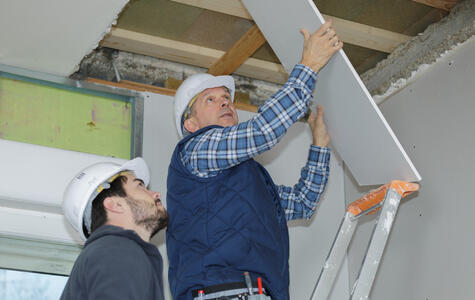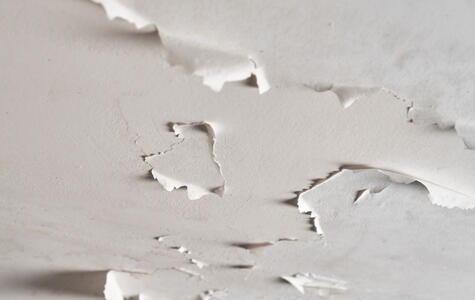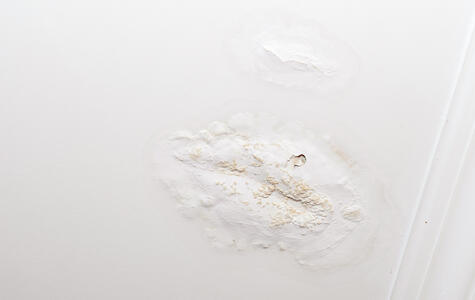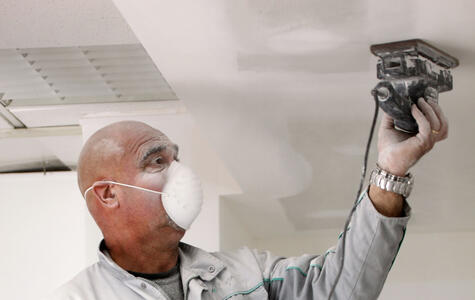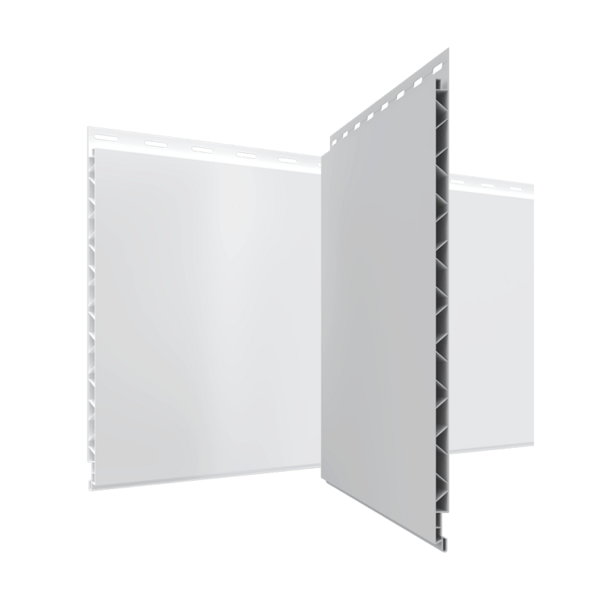A sheet of drywall is made from paper cladding and gypsum, which are both highly absorbent materials that make drywall extremely susceptible to water damage. In your home, there are countless ways your drywall can sustain water damage, including from flooding, burst pipes, roof leaks, air conditioner condensation, shower humidity, and more. No matter how water damage occurs or how long it’s been there, you’ll want to repair it as soon as possible.
- When drywall gets wet, it swells, stains, loses its strength and can become a medium for mold growth
- If you notice tell-tale signs of water damage on drywall, you can call in a professional to repair it or handle it yourself
- In areas of your home that are prone to moisture, humidity, dampness, or flooding, consider using an alternative wall and ceiling material to drywall altogether
How to Tell if Drywall Has Water Damage
Water stains, discoloration, bubbling, peeling paint, sagging, bulging, and soft spots are all visible signs that drywall has water damage.
A small amount of water damage may not seem like a big deal at first, but if left alone, mold can begin growing in as little as 24 to 48 hours. If you notice mold has grown on drywall in your home, don’t attempt to replace it yourself. Instead, call a professional to replace it as soon as possible.
Tools
- Utility knife
- Taping knife
- Drywall saw
- Drywall sander
- Paintbrush
- Screw gun
- Tape measure
Materials
- Drywall sheet
- Drywall screws
- Drywall tape
- Drywall mud
- Furring strip
- Primer
- Paint
How to Repair Drywall with Water Damage
To repair drywall, you’ll need a laundry list of tools and materials to complete the job, including:
If you have the skills, tools, and materials needed to repair drywall on your own and you’re up to the task, take these eight steps:
- Before you start cutting out the damaged drywall, locate the wall studs and check for pipes and electrical wires. Remember to wear a face mask to prevent dust and other small particles from entering your lungs.
- Measure how big of a replacement patch is needed on the wall itself, then mark it out on the new piece of drywall panel.
- Using a utility knife or drywall saw, cut out the damaged drywall and cut a new piece of drywall using the measurements taken before.
- Place the furring strips inside the hole in the wall and attach the new piece of drywall to the strip using drywall screws.
- Using drywall tape, tape the border of the patch where the old and new drywall now meet.
- Apply a thin coat of joint compound over the tape and patch it using the taping knife. After it dries, scrape off any rough parts and repeat this process one to two more times.
- Using your drywall sander, sand the new area to smooth it out. Goggles may be needed during this process to protect your eyes.
- Prime and repaint your drywall.
After you’ve finished all eight steps, your wall should look good as new.

How Much Does It Cost to Repair Drywall Water Damage?
The average cost of drywall per square foot may seem less than other alternatives out there. However, drywall’s short lifespan and its delicacy will cost you in the long run when you factor in the price of tools, materials, labor, and time required to repair or replace it.
You should expect to spend between $300 and $400 on tools and materials alone, plus $10 to $20 per sheet of drywall you need. If you aren’t DIYing the drywall replacement, you can expect to pay an additional $40 to $100 per hour on labor.
How to Prevent Drywall Water Damage
As the saying goes, an ounce of prevention is worth a pound of cure. Your first thought may be to waterproof the drywall in your home, but that won’t work as well as you think it will. In areas of your home that are prone to moisture, humidity, dampness, or flooding, you should consider using an alternative wall and ceiling material to drywall.
PVC-based products like Trusscore Wall&CeilingBoard are a great option for your home’s utility areas — think basements, mudrooms, laundry rooms, and more. Our panels install four times faster than drywall and are 100% waterproof and moisture resistant, which means they’ll never grow mold or mildew. They’re also scratch, dent, and damage resistant, so they’ll last much longer than drywall will.
Plus, if you ever need to replace a panel in the unlikely event you damage one, you’ll need far fewer tools than you do for repairing drywall, and the job will be over before you know it.
Products for Preventing Water Damage
Wall&CeilingBoard
Trusscore Wall&CeilingBoard is an interlocking, interior PVC wall and ceiling panel that is lightweight, low maintenance, and outperforms alternative products like drywall and FRP.
Learn More
